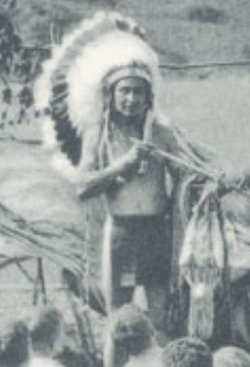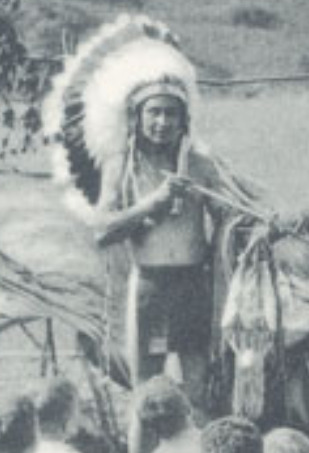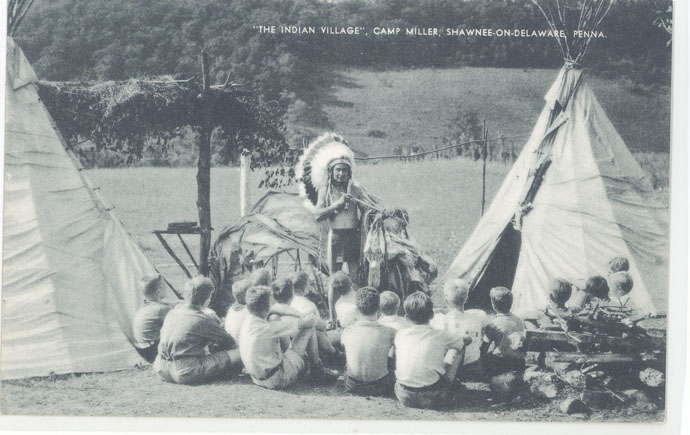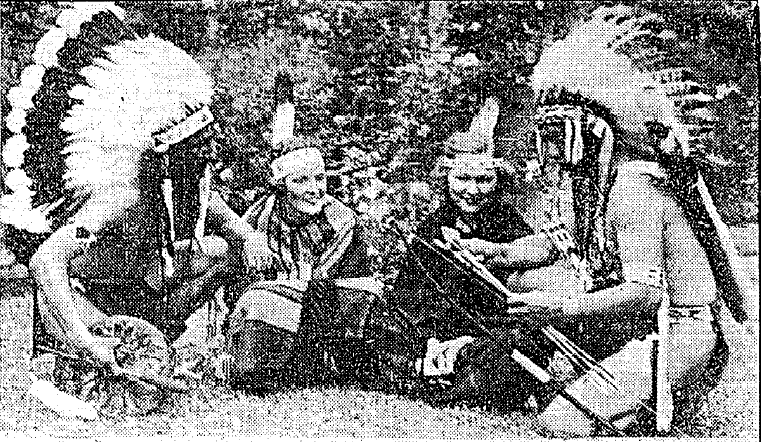Let's remember the times. In the 1920's and 1930's, the United States still had a very repressive Native American policy. Only progressive white thinkers of the times were beginning to appreciate Native American culture or recognize that they had been treated unfairly, or that what they represented was worth examination and preserving.
It wasn't until John Collier began speaking out that "Indians" became admired and appreciated by the American white mainstream. In 1933, during his first year as Commissioner of the Bureau of Indian Affairs, Collier toured many reservations, seeing the conditions and hearing people speak. At one Sioux reservation he made a speech vowing to right some of the wrongs of the past, and about how white Americans were learning native culture was as worthy of admiration as any other. Receiving a beaded pipe bag after his speech, Collier was moved to say,
"When I heard the old men singing when I came in this morning, it gave me the best feeling I have had for three months... And who is there in the State of South Dakota - what white person - who can make anything as beautiful as this?... Five hundred years from now in the future, when there won't be any more railroad trains, and probably there won't be any more automobiles or any more skyscrapers, and when they will have forgotten about most of the things happening in our time, five hundred years from now people all over the world will go and look at things like this and say they are beautiful and great, the work of a great people. This is the old Indian life."
While Collier proposed a great deal, only some of it became reality. Still, he set the tone for better relations for the future, and part of this became the popularization of "Indian" culture among white young people. It was foreign, yet close, ancient, yet still alive. It may have been a bit romanticized or packaged, but to children of the later 1930's and 1940's it was very cool.
One gent (possibly of many) seems to have stepped up to satisfy the desire of white people to learn about Native culture - Chief Bearheart of the Dakota Sioux.
While a great deal of effort was put into the search, very little information can be found presently on Chief Bearheart who is sometimes reported as Chief Bearhart.
It's very clear the chief was active at Camp Miller for boys, as he appears multiple times in newspaper archives:
Reading Eagle (of Reading, Pennsylvania) - July 7, 1936: "Chief Bearhart, full-blooded Sioux, is spending his first season at Camp Miller. Besides assisting in the crafts, he will teach Indian lore and organize and conduct tribal ceremonies with the boys."
Reading Eagle - July 26, 1936 (from a larger article about Camp Miller): "Rehearsals for the seventh annual musical show to be given August 15 will begin next week. Instead of the usual musical comedy of former years, this season's show will be an Indian pageant. Chief Bearheart, full-blooded Sioux Dakota tribe, is writing the pageant and will supervise production details. This is his first year as Indian counselor at Camp Miller, but his experience in Indian lore, crafts, and pageant is long and varied."
Reading Eagle - Jan 19, 1937: "Chief Bearheart, full-blooded Sioux Indian counsellor at Camp Miller, Shawnee-on-Delaware, is a guest of Le Roi E Snyder, 110 Crestmont street, director of the camp."
Reading Eagle - Jul 1, 1937 (from a larger article about the season's opening at Camp Miller): "On Sunday, Chief Bearheart, full-blooded Sioux Indian counsellor, will conduct an induction service and Indian ceremonial."
1936 and 1938 editions of the (Massachusetts) Springfield Republican say he is a Sioux working his way through Springfield College. I also found an article from 1934 about how he'd performed similar services at a summer Camp Ockanickon in Medford, New Jersey, and in February 1940 he spoke and danced and exhibited items at the Mercer County NJ YMCA according to the Trenton Evening Times.
One single paper, the Springfield Republican of April 15, 1937 states his name: Oglala Hoksila. Perhaps it was only another stage name, as that translates roughly to "Oglala lad" - Oglala being a branch of the Sioux.
Whatever the case, it seems that the article to the right that states he was brought up in "Indian Schools" - forced boarding schools established to assimilate Native American youth - was probably right. If he was in college in 1936, he might have been born about 1918 or so, certainly he might have gone through these schools, at least in his early years. If this is true, it seems an irony that a man who had been separated from his culture might be in the absurd position to teach it to the children of the very people who had caused the separation.
So was he cashing in on white people's curiosity? Or was he a sincere tribal ambassador? Or both? It's difficult to say, but it is certain he brought a love of Native American culture to many young campers.
Right up until its closure in the 1970's, Camp Miller had a secret Indian society called "FTF" - the meaning of the acronym known only to its members, but possibly "Follow the Trail of Friendship". The only reason I know this is because as the three Lutheran camps on the Delaware closed, Camp Miller (for boys, where my dad went as a child) was consolidated with Camp Hagan (for girls, where I attended seven years) and became Camp Miller-Hagan. Maybe the boys got first billing, since they lost their camp first.
The FTF ceremony was a dramatic, silent affair conducted at night by a fire. We lowly females were allowed to watch outside the circle. The boys eligible for membership stood in a circle around the fire, ordered not to look behind them. Along the outside of the circle, two boys with a blanket moved silently until they stood behind the next inductee who was to be chosen. Inside the circle, a senior camper barely dressed in a loincloth and painted as an Indian brave ran first one way, then another along the interior, his upheld torch flashing as he ran. Without warning, he'd stop and slam the heel of his hand into the chest of the chosen inductee, who would then fall backwards into the blanket held by the assisting boys outside the ring. After a few words were spoken, the group of newbies would be chased off into the woods by the older members, left to survive three days in the wild with only their clothes, one blanket, a few wooden matches, and their wits. Girls whose boyfriends were chosen for membership got lots of special comforting until their honey returned home safely.
I believe it's very likely FTF came from Chief Bearheart's teachings, probably established by him when Miller was for boys only. Sexist? Maybe... but we girls grinned and amongst ourselves and giggled that FTF stood for "Follow that female".
Let's remember the times. In the 1920's and 1930's, the United States still had a very repressive Native American policy. Only progressive white thinkers of the times were beginning to appreciate Native American culture or recognize that they had been treated unfairly, or that what they represented was worth examination and preserving.
It wasn't until John Collier began speaking out that "Indians" became admired and appreciated by the American white mainstream. In 1933, during his first year as Commissioner of the Bureau of Indian Affairs, Collier toured many reservations, seeing the conditions and hearing people speak. At one Sioux reservation he made a speech vowing to right some of the wrongs of the past, and about how white Americans were learning native culture was as worthy of admiration as any other. Receiving a beaded pipe bag after his speech, Collier was moved to say,
"When I heard the old men singing when I came in this morning, it gave me the best feeling I have had for three months... And who is there in the State of South Dakota - what white person - who can make anything as beautiful as this?... Five hundred years from now in the future, when there won't be any more railroad trains, and probably there won't be any more automobiles or any more skyscrapers, and when they will have forgotten about most of the things happening in our time, five hundred years from now people all over the world will go and look at things like this and say they are beautiful and great, the work of a great people. This is the old Indian life."
While Collier proposed a great deal, only some of it became reality. Still, he set the tone for better relations for the future, and part of this became the popularization of "Indian" culture among white young people. It was foreign, yet close, ancient, yet still alive. It may have been a bit romanticized or packaged, but to children of the later 1930's and 1940's it was very cool.
One gent (possibly of many) seems to have stepped up to satisfy the desire of white people to learn about Native culture - Chief Bearheart of the Dakota Sioux.
While a great deal of effort was put into the search, very little information can be found presently on Chief Bearheart who is sometimes reported as Chief Bearhart.
It's very clear the chief was active at Camp Miller for boys, as he appears multiple times in newspaper archives:
Reading Eagle (of Reading, Pennsylvania) - July 7, 1936: "Chief Bearhart, full-blooded Sioux, is spending his first season at Camp Miller. Besides assisting in the crafts, he will teach Indian lore and organize and conduct tribal ceremonies with the boys."
Reading Eagle - July 26, 1936 (from a larger article about Camp Miller): "Rehearsals for the seventh annual musical show to be given August 15 will begin next week. Instead of the usual musical comedy of former years, this season's show will be an Indian pageant. Chief Bearheart, full-blooded Sioux Dakota tribe, is writing the pageant and will supervise production details. This is his first year as Indian counselor at Camp Miller, but his experience in Indian lore, crafts, and pageant is long and varied."
Reading Eagle - Jan 19, 1937: "Chief Bearheart, full-blooded Sioux Indian counsellor at Camp Miller, Shawnee-on-Delaware, is a guest of Le Roi E Snyder, 110 Crestmont street, director of the camp."
Reading Eagle - Jul 1, 1937 (from a larger article about the season's opening at Camp Miller): "On Sunday, Chief Bearheart, full-blooded Sioux Indian counsellor, will conduct an induction service and Indian ceremonial."
1936 and 1938 editions of the (Massachusetts) Springfield Republican say he is a Sioux working his way through Springfield College. I also found an article from 1934 about how he'd performed similar services at a summer Camp Ockanickon in Medford, New Jersey, and in February 1940 he spoke and danced and exhibited items at the Mercer County NJ YMCA according to the Trenton Evening Times.
One single paper, the Springfield Republican of April 15, 1937 states his name: Oglala Hoksila. Perhaps it was only another stage name, as that translates roughly to "Oglala lad" - Oglala being a branch of the Sioux.
Whatever the case, it seems that the article to the right that states he was brought up in "Indian Schools" - forced boarding schools established to assimilate Native American youth - was probably right. If he was in college in 1936, he might have been born about 1918 or so, certainly he might have gone through these schools, at least in his early years. If this is true, it seems an irony that a man who had been separated from his culture might be in the absurd position to teach it to the children of the very people who had caused the separation.
So was he cashing in on white people's curiosity? Or was he a sincere tribal ambassador? Or both? It's difficult to say, but it is certain he brought a love of Native American culture to many young campers.
Right up until its closure in the 1970's, Camp Miller had a secret Indian society called "FTF" - the meaning of the acronym known only to its members, but possibly "Follow the Trail of Friendship". The only reason I know this is because as the three Lutheran camps on the Delaware closed, Camp Miller (for boys, where my dad went as a child) was consolidated with Camp Hagan (for girls, where I attended seven years) and became Camp Miller-Hagan. Maybe the boys got first billing, since they lost their camp first.
The FTF ceremony was a dramatic, silent affair conducted at night by a fire. We lowly females were allowed to watch outside the circle. The boys eligible for membership stood in a circle around the fire, ordered not to look behind them. Along the outside of the circle, two boys with a blanket moved silently until they stood behind the next inductee who was to be chosen. Inside the circle, a senior camper barely dressed in a loincloth and painted as an Indian brave ran first one way, then another along the interior, his upheld torch flashing as he ran. Without warning, he'd stop and slam the heel of his hand into the chest of the chosen inductee, who would then fall backwards into the blanket held by the assisting boys outside the ring. After a few words were spoken, the group of newbies would be chased off into the woods by the older members, left to survive three days in the wild with only their clothes, one blanket, a few wooden matches, and their wits. Girls whose boyfriends were chosen for membership got lots of special comforting until their honey returned home safely.
I believe it's very likely FTF came from Chief Bearheart's teachings, probably established by him when Miller was for boys only. Sexist? Maybe... but we girls grinned and amongst ourselves and giggled that FTF stood for "Follow that female".
Advertisement
Explore more
Sponsored by Ancestry
Advertisement






